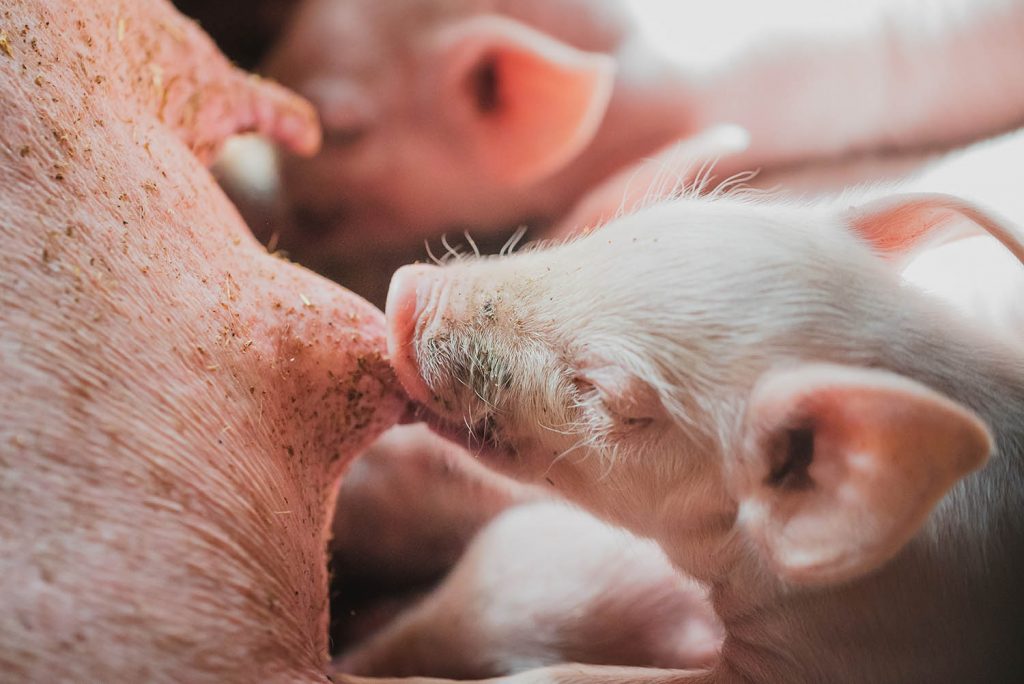28 Mar Consequences of oxidative stress in sow health and performance

During pregnancy, females are at risk of oxidative stress: There is a physiological systemic inflammatory response and a high amount of circulating reactive oxygen species (ROS), produced mainly by the placenta. When the health status is good, oxidative stress is counter-balanced by an increased synthesis of endogenous antioxidants. Late pregnancy is the riskiest period, as the fast fetal growth and the development of the mammary glands result in the generation of more ROS, while at the same time the endogenous antioxidant activity declines. Hyperprolific and overweight sows are the most susceptible to oxidative stress.
In early lactation, sows experience a metabolic shift that puts a lot of pressure on milk synthesis, increasing energy and oxygen demands, and intensifying ROS production.
Oxidative stress damages proteins, lipids and DNA, inducing tissue damages and metabolic impairments in the sow, the placenta, and the litter.
Consequences of oxidative stress on the sow
The combination of genetic selection and early weaning has made it possible for hyperprolific sows to produce more than 35 piglets per sow per year (PSY). However, such a high PSY increases their metabolic burden, inducing oxidative stress. Oxidation leads to:
- A general inflammatory response.
- A decrease in the villus/crypt ratio, which results in a lower nutrient absorption.
- A breakdown of the gut barrier function. The intestine becomes permeable to bacterial toxins, which play an important role in the Postpartum Dysgalactia Syndrome (PDS) and decrease the production of colostrum and milk.
- Reduced appetite in lactating sows, which impairs milk production.
- A shorter productive lifespan.
Besides litter size, there are other factors that increase the risk of oxidative stress, mainly:
- Heat stress
- Poor feed quality
- Presence of mycotoxins, even at low to moderate levels
- Backfat thickness greater than 23 mm
Consequences of oxidative stress on the placenta
Throughout gestation, the placenta evolves to meet the rising requirements of the fetuses. In early gestation, the ROS production is low, but it increases dramatically towards the end of gestation due to its high metabolic activity. Oxidative stress causes:
- Placental inflammation and macrophage infiltration.
- Damage to the placental vessels, which are responsible for the exchange of nutrients, gases, and wastes. The blood flow is reduced, and fetuses cannot receive the nutrients required for proper development.
- Reduction in the expression of proteins related to the transport of glucose, fatty acids and amino acids from the sow to the fetuses.
Consequences of oxidative stress on the offspring
IUGR (intrauterine growth restriction) refers to the impaired growth of the mammalian embryo or fetus during gestation, due to the competition for limited uterine space and nutrients. Nowadays, it is estimated that IUGR occurs in 15-25% of newborn piglets.
In the post-implantation period, there are many embryos in the uterus. Some of them will be lost naturally during the first 30 days of gestation, in order to prevent IUGR in a later stage. Oxidative stress during the first month of pregnancy worsens embryo survivability and may induce birth defects.
On the other hand, the last month of gestation is crucial for fetal growth and, as we explained earlier, it is the riskiest period for oxidative stress. The oxidative damage to the placental blood circulation, the insufficient oxygen supply and the poor nutritional support lead to IUGR. Fetal growth is compromised, some organs and metabolic processes are damaged, and the antioxidant defense mechanism of the fetus is impaired, aggravating oxidative stress.
Affected animals show a low birth, weaning, and final body weight, poor development of the digestive system at birth, weak immunity, high stillborn and mortality rates, and substandard carcass quality.
Use of phytogenics to counteract oxidative stress
In order to increase PSY while at the same time minimizing its negative consequences on the sow and the litter, it is necessary to alleviate the metabolic burden of the sow. The application of antioxidant nutritional strategies is an effective and economical way to reduce oxidative stress and prevent IUGR.
The most common antioxidant nutrients in swine diets are vitamin A, vitamin E, and some trace elements such as selenium. However, vitamins and minerals may show antagonism effects, in example, vitamin A may interfere with the absorption and use of the vitamins D, E and K.
Antioxidant plant-derived compounds, also called phytogenics, constitute an excellent and safe alternative to antioxidant nutrients. The administration of antioxidant phytogenics to pregnant sows during pregnancy and lactation reduces the number of stillborns, increases weight and homogeneity at birth, and boosts health and survivability during the nursery period.
Furthermore, the use of phytogenics has additional advantages, such as the improvement of gut health and the promotion of feed intake.
Products of choice
ReproPlus© is a premix powder intended to maintain and improve digestive health in pregnant and lactating sows. It is formulated with synergistic ingredients:
- Bactericidal and fungicidal phytogenics, combined with organic acids.
- Phytogenics with immune boosting and antioxidant activity.
- Plant extracts with prebiotic effect.
- Vegetable oils rich in omega 3.
- Silicates with mycotoxin binding function.
When administered during the last period of gestation, it has a positive impact on the survivability and the health of the litter.
Do not miss any of our articles!
Subscribe to our monthly newsletter

Certain health statements may not be applicable in your region.

